Battle Surname Ancestry ResultsOur indexes 1000-1999 include entries for the spelling 'battle'. In the period you have requested, we have the following 149 records (displaying 111 to 120): Single Surname Subscription | | | Buying all 149 results of this search individually would cost £814.00. But you can have free access to all 149 records for a year, to view, to save and print, for £100. Save £714.00. More... |
These sample scans are from the original record. You will get scans of the full pages or articles where the surname you searched for has been found. Your web browser may prevent the sample windows from opening; in this case please change your browser settings to allow pop-up windows from this site. Officers of the Royal Naval Reserve
(1904)
The Monthly Naval List for November 1904, printed By Authority for the Admiralty, contains this List of Officers on the Active List, and of Honorary Officers of the Royal Naval Reserve. The list gives names, rank and seniority. The names may be preceded by an asterisk, for those who had completed 12 months' training in the Royal Navy; a further asterisk for 12 months' more service; a dagger for a certificate in a gunnery or torpedo short course; a double dagger for certificates in both. The abbreviations for rank are: A E, assistant engineer; A P, assistant paymaster; Cr, commander; E, engineer; L, lieutenant; Mid, midshipman; P, paymaster; S L, sub-lieutenant; S P, staff paymaster; Sen E, senior engineer; W E, warrant engineer. BATTLE. Cost: £4.00.  | Sample scan, click to enlarge
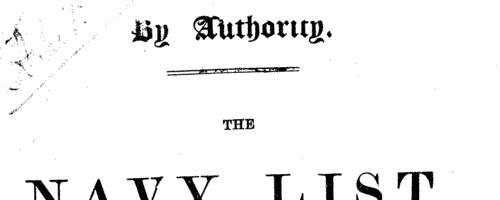
| Student Members of the Institution of Civil Engineers
(1904)
The Institution of Civil Engineers was established 2 January 1818, and incorporated by royal charter 3 June 1828. The annual report lists the names and addresses (throughout the world) of the four classes of member - members (M. Inst. C. E.), associate members (Assoc. M. Inst. C. E.), associates (Assoc. Inst. C. E.), students (Stud. Inst. C. E.) - with the dates of admission. This is the index to the Students. The symbols at the left of each page are + for contributors of papers published in the Minutes of Proceedings, or of an Engineering Conference Note; F for a deliverer of a James Forrest Lecture; L for a deliverer of one of the Special Series of Lectures; and various letters for recipients of certain medals and prizes - B, Bayliss Prize; C, Crampton Prize; f, James Forrest Medal; H, Howard Quinquennial Prize; J, Joule Medal; M, Miller Scholarship; m, Miller Prize; italic m, Manby Premium; S, George Stephenson Medal or Prize; T, Telford Premium; t, Telford Premium; italic t, Trevithick Premium; and W, Watt Medal.BATTLE. Cost: £6.00.  | Sample scan, click to enlarge
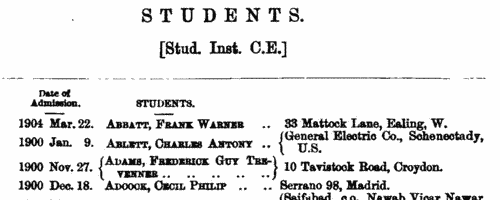
| Government of Burma
(1905)
The India List and India Office List was compiled from official records by direction of the Secretary of State for India in Council, and published by the India Office annually. It covers civil servants and military except for officers drawing substantive pay of less than 500 rupees a month. Names shown in italics are those of officers in foreign service, supernumerary, seconded or employed outside their own departments. This list, for the lieutenant-governorship of Burma, includes the Administration and Officers in the Burma Commission.BATTLE. Cost: £4.00.  | Sample scan, click to enlarge

| Members of Durham University
(1910)
The alphabetical list of all living members of Durham University, issued in 1910, was compiled from the Admission Book and University Register. It gives surname, initials, degree, college, and date. Those marked with an asterisk were Members of Convocation. In the case of graduates in Arts, Theology (except in the case of Bachelors of Divinity) and Civil Law, the dates refer to the year in which the examination for the degree of B.A. was passed; in the case of Bachelors of Divinity who were not Graduates in Arts, of Licentiates in Theology, of Civil Engineers, and of Licentiates in Medicine, to the year in which each passed the Final Examination. In the case of Hygiene, Science, and Music, to the year in which the Examination for B.Hy., B.Sc., or B.Mus. was passed; and in the case of Graduates in Medicine to the year in which the Examination for the degree of M.B. was passed, except in the case of practitioners, when the date refers to the year in which the examination for the degree specified was passed. In cases where no date is given the degree is Ad Eundem, unless it is marked honorary. The abbreviations are: Arms., Armstrong College, Newcastle-upon-Tyne; Codr., Codrington College, Barbados; Cos., Bishop Cosin's Hall; F. Bay, Fourah Bay, Sierra Leone; Hatf., Bishop Hatfield's Hall; Med., College of Medicine, Newcastle-upon-Tyne; St. Chad's, St Chad's Hall; St. John's, St John's Hall; Univ., University College.BATTLE. Cost: £4.00.  | Sample scan, click to enlarge

| Boys entering Gresham's School
(1914)
The Sir John Gresham Grammar School at Holt in Norfolk was founded by sir John, who bought the manor house there in 1546 to convert it into a school, and building work had started by 1555. To celebrate the quatercentenary in 1955, a history of the school written by the Reverend C. L. S. Linnell was published, together with an Alumni Greshamienses, a register of boys entering the school from 1562 to 1954, compiled by A. B. Douglas. The materials to hand for the register for the early years were slight; the first coherent lists of boys survive only from 1729, and then are fitful, with little detail, and largely missing from 1784 to 1803; however, from 1810 onwards the names of boys' parents are usually recorded. The register is arranged chronologically by year (and from 1900 by term - L, Lent; M, Michaelmas; S, Summer), and then alphabetically by surname (in capitals) and christian name(s). Where known, year of birth is then given (in brackets), names, addresses and occupations of parents. From 1900 onwards there are italic abbreviations for sporting achievements at school (h, hockey colours; VIII, shooting colours; S, first-class swimmer; XI, cricket colours; XV, football colours), and p for house prefect and P for school prefect; then (in italics) information about the boy's adult life, and his address (where living) at the time of publication. Finally, on the right hand side of the page, in italics, is given the year of his leaving the school. Most detail is absent before 1810; and, of course, for the boys still at school in 1955, or only recently left, there are no details of future career; nor are there the usual details about their parentage. From 1898 onwards day boys are noted with an italic D (N means Newquay dayboy); and from 1900 onwards the school houses are shown (B, Bengal Lodge; F, Farfield; H, School House or Howson's; K, Kenwyn; O, Old School House; W, Woodlands); and, for the junior school, c, Crossways; k, Kenwyn; o, Old School House).BATTLE. Cost: £4.00.  | Sample scan, click to enlarge
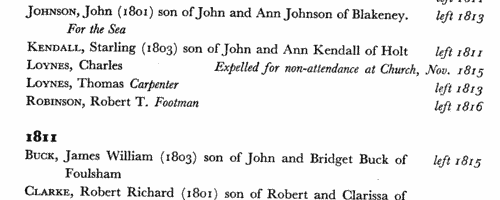
| Grenadier Guards Died in the Great War: Guardsmen
(1914-1918)
203 officers and 4508 other ranks of the Grenadier Guards were killed in the Great War; 242 officers and 6939 men were wounded. This nominal roll lists all the warrant officers, non-commissioned officers and men killed in action, or who died of wounds or disease, in the European war of 1914 to 1918. Arranged alphabetically for each rank, the roll gives regimental number, surname and initials.BATTLE. Cost: £4.00.  | Sample scan, click to enlarge

| Chemists and Druggists
(1919)
The official register printed under the direction of the Pharmaceutical Society of Great Britain pursuant to the act of 31 & 32 Victoriae, cap. 121 (An Act to Regulate the Sale of Poisons, and Alter and Amend the Pharmacy Act, 1852) comprised two sections:
1.The Register of Pharmaceutical Chemists, giving date of registration, number of examination certificate, full name (surname first, in capitals), and residence;
2. The Register of Chemists and Druggists, giving date of registration, full name (surname first, in capitals), residence, number of examination certificate (major or minor), and qualification.BATTLE. Cost: £4.00.  | Sample scan, click to enlarge

| Pharmaceutical Chemists
(1919)
The official register printed under the direction of the Pharmaceutical Society of Great Britain pursuant to the act of 31 & 32 Victoriae, cap. 121 (An Act to Regulate the Sale of Poisons, and Alter and Amend the Pharmacy Act, 1852) comprised two sections:
1.The Register of Pharmaceutical Chemists, giving date of registration, number of examination certificate, full name (surname first, in capitals), and residence;
2. The Register of Chemists and Druggists, giving date of registration, full name (surname first, in capitals), residence, number of examination certificate (major or minor), and qualification.BATTLE. Cost: £4.00.  | Sample scan, click to enlarge

| Boys entering Gresham's School
(1920)
The Sir John Gresham Grammar School at Holt in Norfolk was founded by sir John, who bought the manor house there in 1546 to convert it into a school, and building work had started by 1555. To celebrate the quatercentenary in 1955, a history of the school written by the Reverend C. L. S. Linnell was published, together with an Alumni Greshamienses, a register of boys entering the school from 1562 to 1954, compiled by A. B. Douglas. The materials to hand for the register for the early years were slight; the first coherent lists of boys survive only from 1729, and then are fitful, with little detail, and largely missing from 1784 to 1803; however, from 1810 onwards the names of boys' parents are usually recorded. The register is arranged chronologically by year (and from 1900 by term - L, Lent; M, Michaelmas; S, Summer), and then alphabetically by surname (in capitals) and christian name(s). Where known, year of birth is then given (in brackets), names, addresses and occupations of parents. From 1900 onwards there are italic abbreviations for sporting achievements at school (h, hockey colours; VIII, shooting colours; S, first-class swimmer; XI, cricket colours; XV, football colours), and p for house prefect and P for school prefect; then (in italics) information about the boy's adult life, and his address (where living) at the time of publication. Finally, on the right hand side of the page, in italics, is given the year of his leaving the school. Most detail is absent before 1810; and, of course, for the boys still at school in 1955, or only recently left, there are no details of future career; nor are there the usual details about their parentage. From 1898 onwards day boys are noted with an italic D (N means Newquay dayboy); and from 1900 onwards the school houses are shown (B, Bengal Lodge; F, Farfield; H, School House or Howson's; K, Kenwyn; O, Old School House; W, Woodlands); and, for the junior school, c, Crossways; k, Kenwyn; o, Old School House).BATTLE. Cost: £4.00.  | Sample scan, click to enlarge
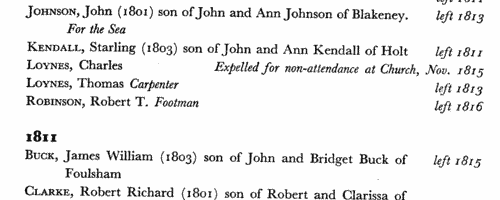
| Naval Officers
(1920)
The alphabetical list of officers on the Active List of the Royal Navy and Royal Marines (RM) and of the Retired and Emergency Officers serving gives: number of ship or where otherwise serving; name (surname, first christian name and initials); rank; and the dates of their seniority. This is the list from the March 1920 edition of the Navy List, corrected to 18 February 1920.
BATTLE. Cost: £4.00.  | Sample scan, click to enlarge
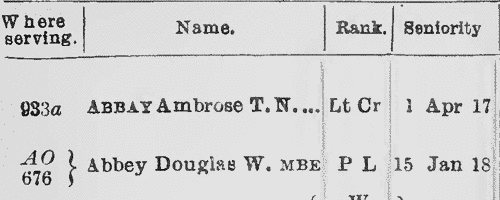
|
Research your ancestry, family history, genealogy and one-name study by direct access to original records and archives indexed by surname.
|












